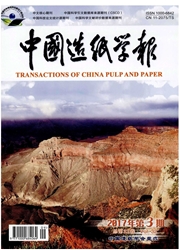

 中文摘要:
中文摘要:
采用扫描电镜(SEM)和凝胶渗透色谱(GPC)技术,研究漆酶和漆酶/丁香酸甲酯(MS)处理前后未漂硫酸盐浆(KP浆)纤维表面形态结构和浆中木素分子质量及其分布的变化,探讨了用漆酶和漆酶/MS处理NKP浆,提高浆张湿抗张强度的相关机理。研究结果表明:与空白样相比,经漆酶处理后,纸浆中木素平均分子质量降低,纤维表面出现“黏结”现象;而MS协同漆酶处理后,纸浆中木素的缩合程度及纤维间的“黏结”面积增大;漆酶和漆酶/MS处理后的浆样再经过加热干燥处理,木素的缩合程度和纤维“黏结”面积进一步增大。木素的缩合程度和纤维表面呈现的“黏结”现象,与漆酶和漆酶/MS处理纸浆提高其湿抗张强度密切相关:
 英文摘要:
英文摘要:
In this paper, the improvement of the property of unbleached kraft pulp by laccase treatment was studied. Fiber morphology, molecular weight and distribution of lignin of the pulp before and atter treatment were analyzed by scanning electron microscope (SEM) and gel permeation chromatography (GPC). The mechanism of wet-strength improvement of the pulp by laccase treatment was discussed. At the same time, the effect of the addition of MS in laccase treatment, molecular weight and its distribution of lignin, morphology of fiber was also studied. The results showed that the molecular weight of lignin decreased and lignin adhered to the fiber surface when the pulp was treated with laccase alone. However, the wet-tensile indexes of handsheets were improved only when the handsheets were dried with heating to improve the polymerization degree and adhesion area of lignin. On the other hand in the laccase treatment with MS, the handsheets could have better wet-tensile indexes without heating drying due to the increase of polymerization degree of lignin and the adhesion area betweem lignin and fibers.
 同期刊论文项目
同期刊论文项目
 同项目期刊论文
同项目期刊论文
 期刊信息
期刊信息
